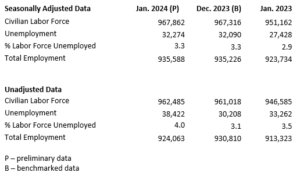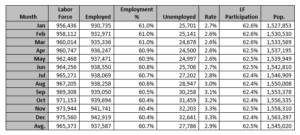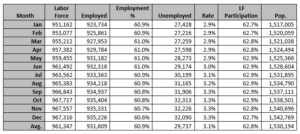
Idaho’s seasonally adjusted unemployment rate was unchanged between December and January, remaining at 3.3%.
December 2023’s unemployment rate also remained the same at 3.3% after the Bureau of Labor Statistics’ annual benchmarking process. (More information about the benchmarking process can be found below.)
January’s labor force increased by 546 people (0.1%) to 967,862.
Idaho’s labor force participation rate – the percentage of people 16 years of age or older who are either employed or looking for work – decreased from December’s 62.7% to 62.6% in January.
Total employment negligibly increased by 362 (0.0%) to 935,588 as unemployment increased by 184 (0.6%) to 32,274.
Idaho’s nonfarm jobs also negligibly increased by 300 (0.0%) to 855,800 in January. Industry sectors with the greatest over-the-month gains included natural resources (2.3%); health care and social services (1.7%); arts, entertainment, and recreation (1.3%); nondurable goods manufacturing (0.9%); federal government (0.7%); construction (0.6%); private educational services (0.6%); state government (0.6%); and professional and business services (0.5%).
Industries that experienced job declines in January included transportation, warehousing, and utilities (-5.3%); wholesale trade (-1.7%); other services (-1.5%); and financial services
(-1.2%).
Three of Idaho’s six Metropolitan Statistical Areas (MSAs) had over-the-month nonfarm job increases in January. Lewiston saw the largest increase of 1%, followed by Idaho Falls (0.2%) and Boise (0.1%). Pocatello and Coeur d’Alene saw decreases of 0.5% and 0.1%, respectively. Twin Falls nonfarm job counts were unchanged in January 2024.
Year over Year
Idaho’s 3.3% unemployment rate for January 2024 was up from 2.9% the prior year. The labor force was up 1.8%, an increase of 16,700 people.
The number of unemployed Idahoans increased 17.7% (4,846) while total employed was 1.3% (11,854) higher over the same period.
Total nonfarm jobs increased by 2% (16,500). Most major industry sectors gained jobs except other services (-3.3%), durable goods manufacturing (-1.8%), finance and insurance (-1%), retail trade (-0.7%), and wholesale trade (-0.6%).
All but one of Idaho’s MSAs saw year-over-year nonfarm job gains in January. Coeur d’Alene had the greatest increase at 4.5%, followed by Lewiston (3%), Idaho Falls (2.5%), Boise (1.6%) and Twin Falls (0.6%). Pocatello experienced a decrease in jobs of 0.3%.
National Comparisons
Nationally, the unemployment rate was also unchanged between December and January, staying at 3.7%. The number of unemployed decreased by 144,000 (-2.3%) to 6.1 million. Total nonfarm payroll employment rose by 353,000 (0.2%) to 157.7 million.

Comparisons – Idaho 2023 Benchmark Statistics
Idaho’s statewide seasonally adjusted annual average unemployment rate was 3.1% for 2023 according to benchmarked numbers released by the Bureau of Labor Statistics (BLS) – up from the 2.9% pre-benchmark average.
The annual average for the state’s civilian population was 14,826 lower (-1%) for a new total of 1,530,194.
Idaho’s labor force estimate was reduced by 4,026 to 961,347 people.
Despite the benchmark lowering both the civilian population and labor force, Idaho’s average labor force participation rate for 2023 was 62.8% – higher than the previously estimated 62.5%.
Post-benchmark, Idaho’s annual average total labor force increased by 1.7% between 2022 and 2023. Total employment increased by 1.5% and the total number of unemployed increased 11.3% from 2022.
The annual BLS benchmark process is conducted in cooperation with the Idaho Department of Labor and includes re-estimations based on updated data from the U.S. Census Bureau, BLS and other sources.




